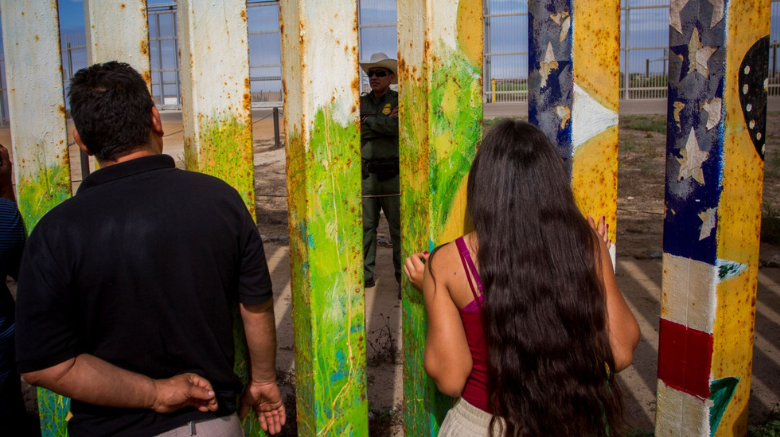What’s happening?
Last week, United States President Joe Biden announced a new executive order prohibiting people who irregularly cross the US-Mexico border from applying for asylum. According to the White House, these restrictions took effect at midnight last Wednesday. This measure deviates from a protocol that has been in place for decades, and now prevents irregular arrivals from applying for asylum once a daily threshold of crossings has been reached during a 7-day period. The policy will be activated when the daily average exceeds 2,500 crossings, and deactivated when the daily average falls below 1,500.
In May, about 3,800 arrivals crossed the border daily, totaling 118,000 apprehensions for the month, a high figure but lower than the peak levels of last December, when the number exceeded 250,000.
This action aims to address one of the president’s most pressing political issues in his race for re-election, and was announced just weeks before the first debate between Biden and his opponent, former President Donald Trump. The measure uses the same authority Trump sought to employ during his term in office, which was criticized by Biden back then.
According to Blas Núñez-Neto, Assistant Secretary for Border and Immigration Policy these measures, although not permanent, will be in place for a while and will allow authorities to return many more people more quickly. The new rules establish that undocumented people crossing the border will not be eligible to apply for asylum, with exceptions for unaccompanied children, victims of trafficking, and people with serious medical emergencies. Detainees will be subject to expedited removal and will only have the opportunity to see an asylum officer if they express fear of returning to their country. Asylum interviews will be conducted with a higher standard than previously used.
To apply for asylum during the term of the restriction, a person must prove that there is a “reasonable possibility” that they will be persecuted or tortured if sent back to their country of origin. This standard is much higher than the current standard and requires applicants to present more evidence to immigration authorities at the border.
Background
Last month, President Biden announced another immigration measure that provides for the expedited removal of people seeking asylum – some deported to their countries of origin, and many sent back to Mexico. Biden signed this executive order just five months before the presidential election, where irregular migration is one of the central issues. Thousands of people continue to arrive daily at the U.S. southern border.
The Refugee Act of 1980, codified as Section 208 of the Immigration and Nationality Act (INA), ensures that any non-citizen on US soil has the right to request asylum if they fear for their life or freedom due to race, religion, nationality, membership in a particular social group, or political opinion. This law mandates due process for asylum requests regardless of the manner of arrival in the United States, aligning the country with the 1951 Refugee Convention.
What are the implications for Mexico?
Local authorities in Mexico’s border states fear that the measures announced by Biden will overwhelm shelters and cause chaos at the border. There is concern over the lack of clarity about what will happen to migrants who exceed the 2,500 daily crossings allowed. Currently, Tijuana’s 33 shelters, with a total capacity of 5,500 people, house 3,500 of them, but could quickly become overcrowded if the measure goes into effect.
Mexico also receives up to 30,000 deported citizens monthly from Cuba, Haiti, Nicaragua, and Venezuela under an existing agreement with the US. In addition, there is a humanitarian parole program that allows for the legal entry of up to 30,000 people seeking asylum from these four countries each month. Experts believe that the recent reduction in border crossings is only temporary and ultimately unsustainable.
Will these measures “close” the border?
No. The restrictions apply to people crossing between ports of entry, but will not block access to those who request an appointment to approach a legal port of entry through a government-run mobile app. Others who have applied from abroad to enter through various temporary stay programs put in place by the Biden administration or temporary work visa holders will be allowed entry. The ban will also not apply to unaccompanied minors, persons with serious medical or security threats, and victims of human trafficking.
Asylum Access’s concerns
At Asylum Access Mexico and Asylum Access Global we are deeply concerned about the new measures. We believe that these policies will increase the risks for people seeking asylum, many of whom are fleeing situations of violence and persecution. We warn that the restriction of access to asylum and accelerated deportations could lead many people to situations of imminent danger as they are returned to their countries of origin without an adequate assessment of their cases.
In addition, we note that the overcrowding of shelters at the Mexican border could worsen the living conditions of forcibly displaced people, creating an environment conducive to abuses and human rights violations. We urge the US and Mexican governments to consider more humane and fair solutions to ensure the protection of those seeking international protection.

